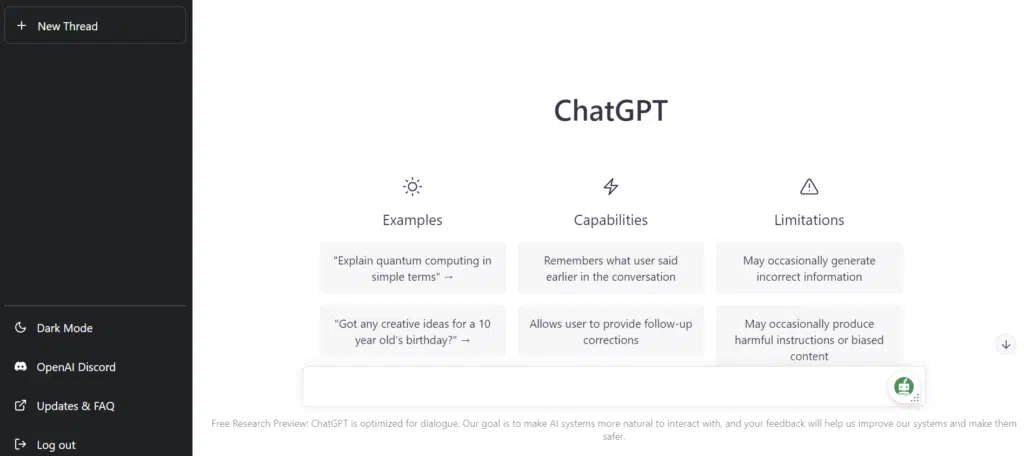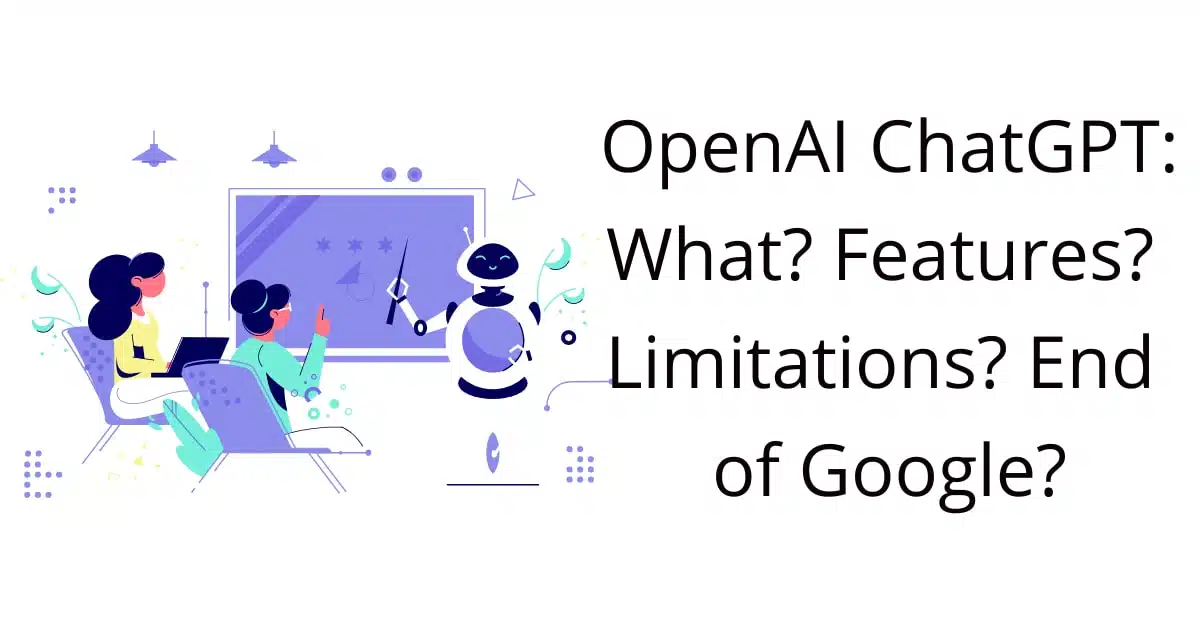OpenAI ChatGPT is a powerful chatbot developed by the OpenAI artificial intelligence research laboratory. It is based on the popular GPT-3 (Generative Pretrained Transformer-3) language model and is capable of engaging in human-like conversations on a wide range of topics. In this article, we will explore what is ChatGPT, the ChatGPT features, what chatGPT is used for, and the limitations of OpenAI ChatGPT, as well as discuss its potential impact on the tech industry and the future of search engines like Google.
What is ChatGPT?
It is an AI chatbot ChatGPT that uses natural language processing (NLP) and deep learning to understand and respond to user input. It is designed to provide a more natural and intuitive way for people to interact with machines. It can be used for a variety of applications, such as customer service, virtual assistants, and more.
ChatGPT works by using natural language processing (NLP) and deep learning to understand and respond to user input. It is trained on large datasets of conversations and can learn to recognize patterns in language and respond appropriately. One of ChatGPT features is that it can also be trained to understand specific topics and respond to questions related to those topics. ChatGPT can provide a more natural and intuitive way for people to interact with machines. ChatGPT is used for a variety of applications.
What ChatGPT is used for?
While reading about what is ChatGPT, the next question that comes to mind is what are the uses of chatGPT. One of the key uses of OpenAI ChatGPT is to improve customer service for businesses. The ChatGPT can handle a high volume of customer inquiries, providing quick and accurate responses to common questions. This can save businesses time and resources, allowing them to focus on other tasks. Additionally, the chatbot can improve the customer experience by providing timely and helpful information.
ChatGPT is used for research and development. ChatGPT can be used to analyze large amounts of text data and identify trends and patterns. This can help businesses and organizations make better-informed decisions and drive innovation.
Overall, OpenAI ChatGPT has several potential uses and can provide businesses and organizations with valuable insights and assistance It is a powerful tool that has the potential to revolutionize the way we interact with technology.
Key Features of ChatGPT
On top of GPT-3, ChatGPT was improved using supervised learning and reinforcement learning. Both strategies made use of human trainers to enhance the performance of the model. For supervised learning, the trainers acted as both the user and the AI assistant in dialogues that were given to the model. Human trainers ranked the model’s responses from an earlier conversation as the first step in the reinforcement stage. These rankings were used to produce “reward models,” on which the model was further improved by several proximal policy optimization iterations (PPO). Trust region policy optimization methods can benefit from proximal policy optimization algorithms since they eliminate many of the computationally expensive operations and execute more quickly.
Natural Language Understanding
ChatGPT can understand natural language input from users. It uses deep learning algorithms to process user input and generate appropriate responses. This allows users to have more natural conversations with the chatbot, as it can understand the context and intent of the user’s input.
Contextual Responses
ChatGPT can generate contextual responses to user input. It can understand the context of the conversation and generate appropriate responses. This allows users to have more natural conversations with the chatbot, as it can understand the context and intent of the user’s input.
Personalization
ChatGPT can personalize its responses to each user. It can learn from user input and generate more personalized responses. This allows users to have more natural conversations with the chatbot, as it can understand the context and intent of the user’s input.
ChatGPT is designed to provide a more natural and conversational experience than traditional chatbots, with ChatGPT features such as natural language understanding, contextual responses, and personalization. These features allow ChatGPT to have a more natural conversation with users.
Limitations of ChatGPT
False Answers
As a language model, ChatGPT will invariably give incorrect responses. In certain cases, it is incredibly incorrect. Andrew Ng, a computer scientist, thinks it’s “sometimes hilariously wrong.” Sometimes ChatGPT seems quite sure of its answers, even when they are incorrect, which could be dangerous because you can’t detect when it’s incorrect unless you already know the right answer.
Data Limitations in Training
One of ChatGPT limitations is that its training data is constrained, as is the case with many AI models. Both a lack of training data and bias in the data might have a negative impact on the model’s output. This is a well-known issue with AI, and there are several solutions to the problem of bias. One solution is to include more diverse training data.
Bias Problems
ChatGPT has the potential to produce biased results. ChatGPT has shown bias against underrepresented groups. The model will always be biased if the training set of data is biased. Nearly all AI tools struggle with this, so it’s crucial to keep this in mind and take it into account as we work to assure justice and lessen bias in technology.
Sustainability
On Twitter, there is a conversation over how many GPUs are required to run ChatGPT. The lesson here is that running ChatGPT is highly expensive. Given that ChatGPT is a free product, it’s unknown how long it will be able to run and how sustainable it is.
Even though ChatGPT has generated enthusiasm in the community and shown suitability for numerous relevant use cases, it is still uncertain if and when it can be used commercially, given all of the aforementioned ChatGPT limitations. However, I have faith that they will be able to get above these ChatGPT limitations, and I eagerly await the next development!
End of Google?
OpenAI’s ChatGPT is a state-of-the-art natural language processing model that has the ability to hold conversations with humans. With its ability to generate human-like responses, some people may be wondering if ChatGPT is the end of search engines like Google.
It’s important to understand that ChatGPT is not a replacement for search engines like Google. ChatGPT is specifically designed to hold conversational exchanges with humans, whereas search engines like Google are designed to retrieve information based on specific keywords or queries. This means that ChatGPT is not capable of providing the same level of comprehensive information retrieval that search engines are able to provide.
In contrast, search engines like Google can access a vast amount of information from a wide range of sources, including websites, databases, and other sources of information. This means that search engines can provide more comprehensive and accurate answers to a wider range of queries.
Furthermore, ChatGPT is not capable of replacing the many other functions that search engines like Google provide, such as email services, cloud storage, and map services, among others. This means that even if ChatGPT were able to provide answers to some of the same types of questions that search engines can answer, it would not be able to provide the same level of convenience and utility that search engines offer.
Also take into account Google’s ownership of YouTube, which has nothing to do with AI-generated material. Millions of individuals can post content on everything from how to run an Airbnb (ABNB) business to how to hit a sand wedge, to gardening, and fitness, in place of an all-knowing AI. YouTube has a substantial network effect and monopolistic dominance of the internet video business; AI wasn’t intended to be employed in YouTube’s manner of operation. Although ChatGPT is tremendously strong, I’m still figuring out what its best applications are. Google appears to be king for Internet research when there are conflicting viewpoints, vested interests, or a limited amount of time.
Also Check : Impact of Artificial Intelligence on Digital Marketing
ChatGPT is not the end of search engines like Google. While it is a powerful tool for holding conversational exchanges with humans, it is not a replacement for the comprehensive information retrieval capabilities of search engines. It is simply a new tool that can be used in conjunction with existing search engines to enhance human-computer interaction. It is not capable of providing the same level of comprehensive information retrieval or convenience that search engines offer, and it should not be considered a replacement for search engines.
How to access ChatGPT?
To access ChatGPT, you will need to visit the OpenAI website and create an account. Once you have created an account, you can access ChatGPT through OpenAI by using a compatible programming language.

If you are not familiar with programming, you can also access the AI chatbot ChatGPT through several third-party applications that are available online. These applications allow you to interact with ChatGPT using natural language, without the need for any programming knowledge. It is also possible to access ChatGPT through several chatbots that are available on messaging platforms like Facebook Messenger and Slack.
Conclusion
ChatGPT is a chatbot trained using the GPT-3 (Generative Pretrained Transformer-3) language model. It is capable of generating human-like text responses to user input in a variety of formats, including chat conversations and natural language processing tasks. ChatGPT can be used for a range of applications, including customer service, personal assistants, and entertainment.
FAQs
Is ChatGPT free?
Yes, ChatGPT is 100% free to use.
Who owns ChatGPT?
As of now, ChatGPT, the new language processing AI from OpenAI.
Did Elon Musk make ChatGPT?
With the declared objective of promoting and developing benign AI in a way that benefits humanity as a whole, the OpenAI company carries out research in the field of AI. Sam Altman, Elon Musk, and others formed the group in San Francisco at the end of 2015 with a US$1 billion promise.
What is GPT in ChatGPT?
GPT stands for Generative Pretrained Transformer. It is a type of language model that uses deep learning techniques to generate human-like text. The GPT-3 model, which ChatGPT is trained on, is one of the most advanced language models currently available and can generate text that is highly coherent and realistic. It is trained on a vast amount of text data and is able to generate responses to user input by predicting the next most likely words in a sequence. This allows it to generate responses that are relevant to the context of the conversation and that can continue the conversation in a natural way.

